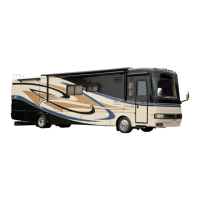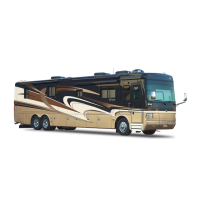Do you have a question about the Monaco LaPalma and is the answer not in the manual?
Details the duration and mileage for motorhome warranty coverage based on usage type.
Discusses limitations on implied warranties like merchantability and fitness for a particular purpose.
Explains the process for repair or replacement of covered defects, including owner responsibilities.
Provides instructions on contacting authorized service centers and obtaining warranty service.
Lists items and conditions explicitly excluded from warranty coverage.
Details events like misuse, neglect, or accidents that void warranty obligations.
States that the warrantor is not liable for consequential or incidental damages resulting from defects.
Outlines legal rights of the owner and limitations on enforcing warranty claims.
Explains the meaning of various safety symbols used throughout the manual for warnings and cautions.
Instructs owners on reporting safety defects to NHTSA and Monaco Coach for investigation.
Details owner's responsibilities for regular maintenance and seeking authorized service.
Provides space to record serial numbers for motorhome and its components for reference.
Explains causes of corrosion on the motorhome and how to minimize it.
Details proper washing techniques for the motorhome's paint finish to preserve its appearance.
Emphasizes the importance of periodic resealing of joints and seams to prevent moisture intrusion.
Guides on cleaning upholstery fabrics, emphasizing the use of correct cleaning codes.
Explains what mold is, what it needs to grow, and the consequences of mold growth in a motorhome.
Discusses pest identification, common pests, and steps to take for pest infestation control.
Provides a checklist for short-term storage (30 days or less) to prepare the motorhome for storage.
Explains how the motorhome refrigerator operates differently from household models and proper care.
Introduces the microwave section, covering its features and heating principles.
Explains the operation of the cooktop, including its electric ignition system and surface burner usage.
Explains the furnace operation, fuel source, and safety warnings related to LP-Gas usage.
Explains the two methods of heating water (120V AC and LP-Gas) and the basic components of the water heater.
Describes the automatic washer-dryer's capacity, features, and provides a test procedure before first use or after storage.
Explains the operation of the entry step, including its lighting, automatic retraction, and manual override features.
Explains slide-out room operation, safety features, and general maintenance guidelines for longevity.
Introduces awnings and covers window, patio, and automatic awnings, including care.
Covers the operation and maintenance of exhaust and bathroom fans.
Introduces the entertainment center components and their general operations, referring to the Video Selector Box section.
Explains the operation of the manual crank-up antenna, including signal boosting and troubleshooting for picture issues.
Explains the location and function of the monitor panel for managing storage tanks and reading tank levels.
Explains the function and operation of the water pump, including its automatic and self-priming nature.
Provides troubleshooting steps for common water pump issues, such as failure to start, prime, shut off, or noisy operation.
Provides a procedure for disinfecting the fresh water system using chlorine bleach to prevent contamination.
Introduces the waste water system, covering proper waste disposal regulations and common practices.
Explains the toilet operation, cleaning, maintenance, and safety cautions for holding tank chemicals.
Details methods for winterizing the motorhome's water system using air pressure or RV antifreeze.
Introduces the LP-Gas system, covering its operation, care, and equipment approved for RV use.
Explains the LP-Gas detector's purpose, function, and sensitivity to various gases and fumes.
Lists immediate steps to take if gas odor is detected, emphasizing safety precautions and contacting service.
Provides basic facts about LP-Gas, including its properties, BTU ratings, and conversion data.
Explains the function of the two-stage regulator in reducing LP-Gas pressure and preventing freeze-up.
Details procedures for inspecting LP-Gas supply hoses for damage and recommends periodic replacement.
Introduces the motorhome's electrical system, covering AC and DC power sources and components.
Details the requirements for AC system power, connecting to shore power, and using adapters.
Covers the importance of the 12 Volt DC system for lighting and appliances, emphasizing voltage sensitivity.
Explains the location and function of the battery cut-off switch for controlling 12V DC power and conserving battery power.
Explains the basic chemical reaction and operation of a 12 Volt battery.
Guides on monitoring battery status using the monitor panel and testing electrolyte levels with a hydrometer.
Details how temperature and activity affect hydrometer readings and provides warnings about handling sulfuric acid.
Details under-hood checks for the Ford chassis, including fluid reservoirs and oil filter.
Details under-hood checks for the Workhorse chassis, including fluid reservoirs and oil recommendations.
Provides a tire chart listing various tire sizes, speed ratings, and recommended inflation pressures for dual and single configurations.
Provides engine specifications for Ford and Workhorse chassis, including engine type, size, and tire size.
Provides a template for recording scheduled service dates, odometer readings, and job performed.
Provides detailed guidance and safety tips for safely backing up a motorhome.
Discusses pest identification, common pests, and steps to take for pest infestation control.
Explains the LP-Gas detector's purpose, function, and sensitivity to various gases and fumes.
Details methods for winterizing the motorhome's water system using air pressure or RV antifreeze.
Provides troubleshooting steps for common water pump issues, such as failure to start, prime, shut off, or noisy operation.
Covers tire components, importance of air pressure, charts, care, and troubleshooting for tire issues.
| Brand | Monaco |
|---|---|
| Model | LaPalma |
| Category | Motorhomes |
| Language | English |

